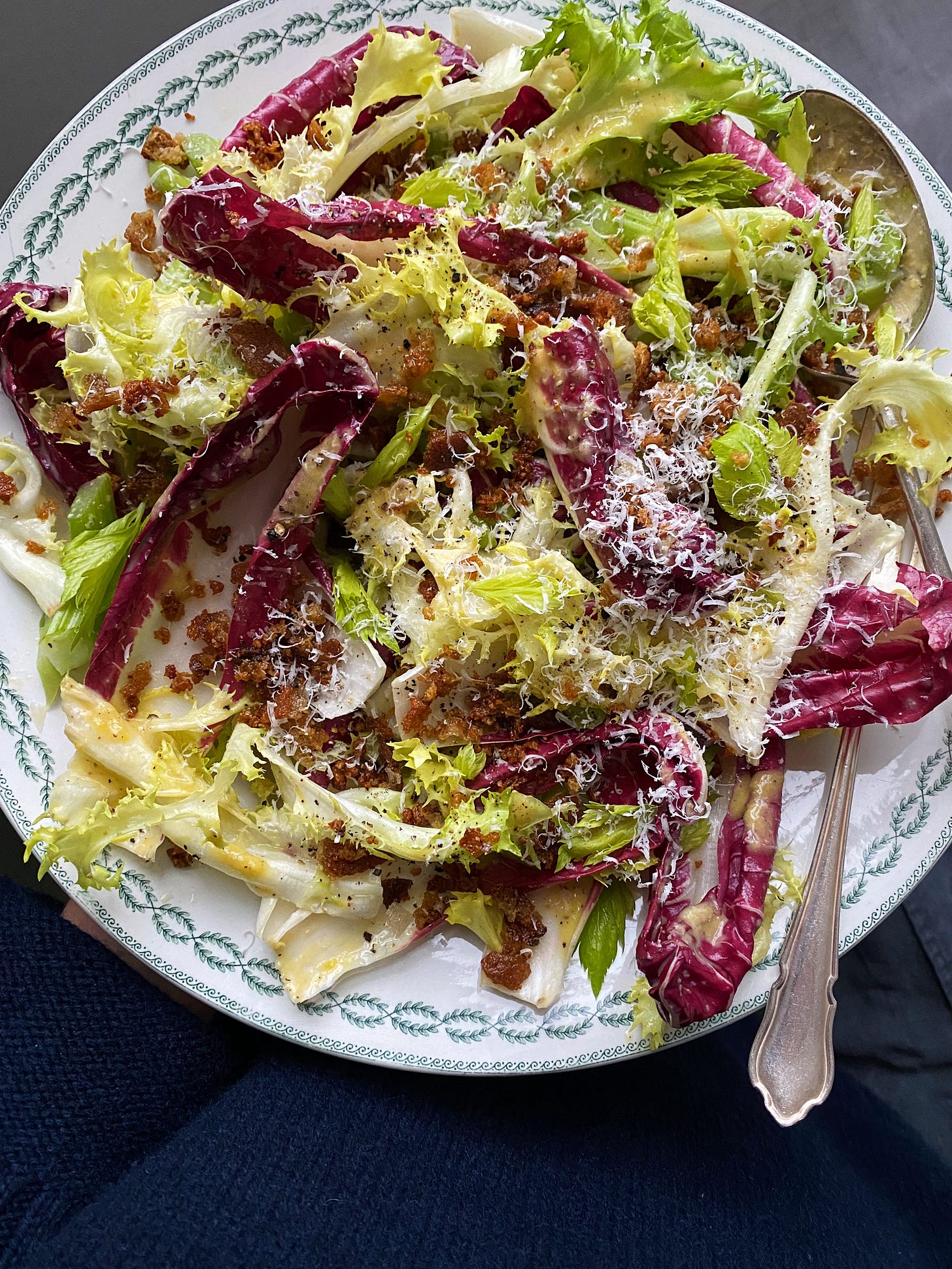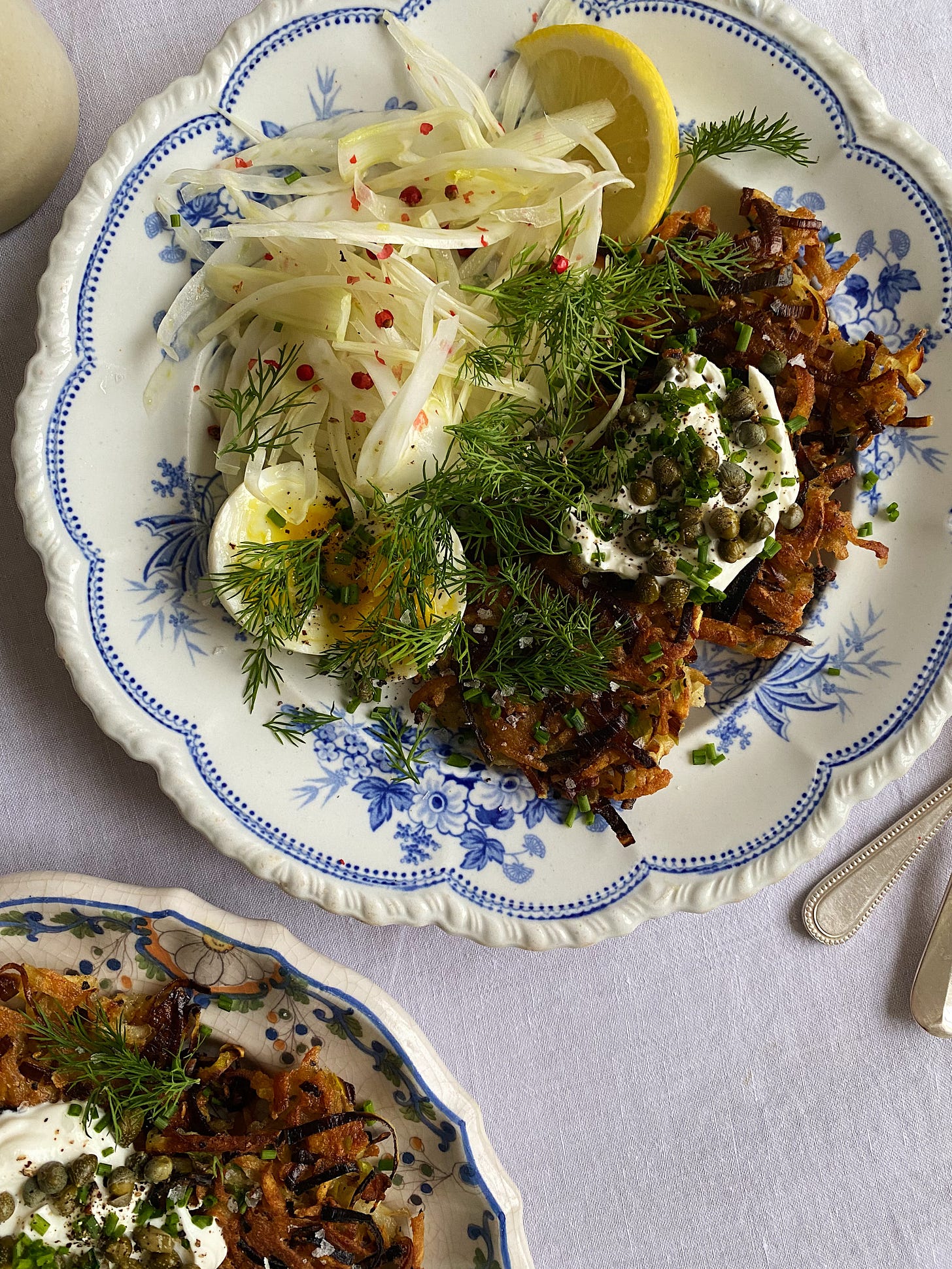For me, December eating is led by tradition more than any other month. There are a number of non-negotiables. Curls of smoked salmon draped over rye bread. Buttery chestnuts prized from their shells, still warm from a stint in the log burner. Not one but two different stuffings from the old Josceline Dimbleby Christmas book, the pages of which are splattered with melted butter and barely held together by a well-worn spine that is a telling sign of the book’s age and use (a double batch of both stuffings because they are without doubt the best things on the Christmas Day table and the possibility of not having leftovers to see us through to New Year is, quite frankly, unthinkable). Large bowls of segmented oranges, pomegranate and mint that are gobbled up in considerably less time than it takes to prepare them. Doorstep slices of Nigella’s prune and chocolate cake, the only cake I make out of choice all year.
Less specifically but no less significantly, December is also the month that I make bitter salads and fritters on repeat. There isn’t much rhyme or reason to this tradition, but it’s a tradition nonetheless and I’m fairly certain the same could be said for lots of “festive” traditions (ooof “festive” is really icky word but quite hard to replace it seems). The bitter salads feature in various guises: with citrus and milky mozzarella; with shaved apple and toasted pecans; or with celery, caesar dressing and crispy anchovy breadcrumbs, as below. In terms of the fritters, again I take these in different directions depending on what root veg I’m drawn to at the shops and sometimes use the batter to make one large rosti rather than individual fritters. Here I’m sharing a recipe for my leek and potato version with pickles and herbs.
Both the salad and the fritters more than hold their own but equally would sit well alongside the dishes that lots of us make over the coming weeks in the run up to and over Christmas, as tradition dictates.
Bitter caesar
Serves 4
150ml olive oil
1 tin of anchovies (about 8-10 fillets)
50g coarse fresh breadcrumbs
1 egg yolk
1 tbsp dijon mustard
1 garlic clove
1 lemon
30g parmesan
1 small radicchio or 2 heads of chicory
1/2 head of frisée or other bitter lettuce
3 celery sticks, plus the leaves if possible
Heat 50ml olive oil in a frying pan over a medium heat. Once shimmering, add half the anchovy fillets. Stir into the oil to melt then add the breadcrumbs and fry for about 3-4 minutes, stirring fairly regularly, until deeply golden and crisp. Remove from the heat and set aside to cool as you make the dressing.
Put the egg yolk and dijon in a medium bowl. Finely grate in the garlic clove and the zest of the lemon. Using the side of a chefs knife, smoosh the remaining anchovy fillets to a paste then add these to the bowl. Grind in lots and lots of black pepper. Whisk to combine. Slowly drizzle in the remaining 100ml olive oil, whisking continuously. Finely grate just over half the parmesan into the dressing, mix, then finally add the juice of half the lemon. Taste and adjust, making sure there is plenty of black pepper to cut through the parmesan. It should be really punchy.
Pull apart the leaves of the radicchio and lettuce. Roughly chop the celery. In a large bowl, toss the radicchio, lettuce and celery with the juice of the other lemon half. Add about half of the dressing to start with and toss well (I think tossing with your hands is best here to distribute and incorporate the dressing). Taste and adjust, adding a little more dressing and seasoning lightly with salt if needed (the anchovy and parmesan are salty so this may not be necessary). Top with the breadcrumbs, celery leaves and remaining parmesan.
Leek and potato fritters with pickles and herbs
The recipe below is for the fritters themselves and I leave the toppings/general accoutrements up to you. I love them with dollops of yoghurt, pickles (capers, cornichons, sauerkraut or kimchi would all work well) and lots of herbs because I am nothing if not predictable in my palette. This makes about 24 fritters which feeds at least 6 people, if not more depending on what you’re serving them with. If you’re not as greedy as us, or you’re cooking for a smaller number of people you could halve the recipe. However, they reheat well the next day, or even the day after (blast in a hot oven), so I would just make the full quantity and look forward to the leftovers.
Before I get into the recipe here are some opinionated, granular thoughts on the pursuit of the crispiest of crispy fritters (NB these bossy specifications are not prerequisites for making the fritters, merely steps that I consider to be worth taking if possible).
i) Squeeze the living daylights out of those potatoes. Water inhibits browning and crisping so you want to extract as much of it as possible from the potatoes. I find squeezing the potatoes through a muslin cloth is the best way to go about this but if you don’t have a piece of muslin you can squeeze handfuls over a colander. When you think you’ve squeezed enough, squeeze some more. And then squeeze some more.
ii) Leeks need a good wash to get rid of the grit that is often hiding within the layers but the same principle applies - get rid of as much water as possible. If you have one, a salad spinner is ideal for this.
iii) In terms of flour, rice flour is my preference. I understand this may not be in everyone’s cupboards as standard but I do think it’s worth adding to the collection. It doesn't go gummy in the way that wheat flours can in batters; instead it gives light, crispy results.
iv) I like to fry my fritters in ghee as it has a high smoke point so can withstand the medium-high heat that is needed for crisping up the fritters, and I prefer its flavour to that of seed oils like rapeseed or sunflower. But you do you; if you would rather use a neutral oil, go ahead. If you are using ghee, please, please use ghee from a jar rather than a tin - the flavour is completely different.
v) When adding the fritter mixture to the pan, try not to pack it down into a neat patty. Instead, keep the mixture loose and shaggy with straggly bits of potato and leek. That way your fritters will be lighter with plenty of crispy edges.
vi) To keep the fritters warm and crisp while you continue to fry the rest of the mixture, put them on a wire rack set over a baking tray in a low oven. This allows air to circulate around both the top and the bottom of the fritters, whereas if you put them directly on a tray or on paper towels the bottom is likely to lose its crispiness.
Makes approximately 24 fritters
700g Maris Piper potatoes
2 small leeks (about 200g)
2 garlic cloves
1 lemon
2 eggs
3 tbsp rice flour
Ghee for frying
Topping suggestions: yoghurt (or sour cream or creme fraiche), soft herbs (dill and chives are my favourites here), pickles
Coarsely grate the potatoes lengthwise (this creates longer bits of potato meaning there’s more potential for straggly bits to crisp up) into a large bowl and sprinkle with salt. Set aside as you prepare the leeks; in this time the salt will bring out some of the water from the potatoes.
Cut the leeks in half lengthwise and finely slice. Rinse well and dry thoroughly.
Squeeze as much liquid as possible from the potatoes (see note above - muslin as preference, handfuls over a colander as the next best option). Squeeze some more. Transfer back to the large bowl along with the leeks. Finely grate in the garlic cloves and the zest of the lemon. Make a little well to crack in the eggs, whisk them thoroughly, then add the flour. Season generously with salt (most of the salt you used on the potatoes in the first step has gone down the drain) and lots of black pepper. Mix well to combine.
Melt a blob of ghee in a large, heavy based frying pan (cast iron if possible) over a medium-high heat. Once hot, spoon a small test fritter into the pan and fry until deeply golden on both sides. Taste for seasoning and adjust the mixture with a little more flour if needed. Fry the fritters in batches, being careful not to overcrowd the pan, adding ghee as needed (be generous with the ghee as this is key to deeply golden, crisp fritters) and scooping up any stray bits of potato or leek left in the pan between batches. I like to get two frying pans on the go for time efficiency purposes. As noted above, keep the fritters warm in a low oven on a wire rack set over a baking tray.
Serve warm with whatever toppings take your fancy.





